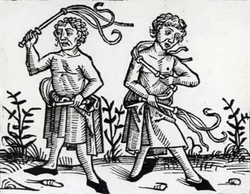Scourge
A scourge is a whip or lash, especially a multi-thong type, used to inflict severe corporal punishment or self-mortification. It is usually made of leather.

Etymology
The word is most commonly considered to be derived from Old French escorgier - "to whip", going further back to the Vulgar Latin excorrigiare: the Latin prefix ex- "out, off" with its additional English meaning of "thoroughly", plus corrigia - "thong", or in this case "whip". Some connect it to Latin: excoriare, "to flay", built of two Latin parts, ex- ("off") and corium, "skin".
Description

A scourge (Latin: flagrum; diminutive: flagellum) typically consists of several thongs fastened to a handle. A well known configuration of a scourge is the cat o' nine tails. The cat o' nine tails has two versions: the navy version is made of thick ropes with knotted ends, the army and civil prison versions are usually made of leather.[1]
The scourge, or flail, and the crook are the two symbols of power and domination depicted in the hands of Osiris in Egyptian monuments.[2] The shape of the flail or scourge is unchanged throughout history.[1] However, when a scourge is described as a 'flail' as depicted in Egyptian mythology, it may be referring to use as an agricultural instrument. A flail was used to thresh wheat, not implement corporal punishment.[3]
The priests of Cybele scourged themselves and others. Such stripes were considered sacred.[4]
Hard material can be affixed to multiple thongs to give a flesh-tearing "bite". A scourge with these additions is called a scorpion. Scorpio is Latin for a Roman flagrum and is referred to in the Bible: 1 Kings 12:11: "...My father scourged you with whips; I will scourge you with scorpions" said Rehoboam, referring to increased conscription and taxation beyond Solomon's. The name testifies to the pain caused by the arachnid. Testifying to its generous Roman application is the existence of the Latin words Flagrifer 'carrying a whip' and Flagritriba 'often-lashed slave'.[4] According to the Gospel of John, Pontius Pilate, the Roman governor of Judea, ordered Jesus to be scourged.[5]

Scourging was soon adopted as a sanction in the monastic discipline of the fifth and following centuries. Early in the fifth century it is mentioned by Palladius of Galatia in the Historia Lausiaca,[6] and Socrates Scholasticus[7] tells us that, instead of being excommunicated, offending young monks were scourged. (See the sixth-century rules of St. Cæsarius of Arles for nuns,[8] and of St. Aurelian of Arles.[9]) Thenceforth scourging is frequently mentioned in monastic rules and councils as a preservative of discipline.[10] Its use as a punishment was general in the seventh century in all monasteries of the severe Columban rule.[11]
Canon law (Decree of Gratian, Decretals of Gregory IX) recognized it as a punishment for ecclesiastics; even as late as the sixteenth and seventeenth centuries, it appears in ecclesiastical legislation as a punishment for blasphemy, concubinage and simony. Though doubtless at an early date a private means of penance and mortification, such use is publicly exemplified in the tenth and eleventh centuries by the lives of St. Dominic Loricatus[12] and St. Peter Damian (died 1072). The latter wrote a special treatise in praise of self-flagellation; though blamed by some contemporaries for excess of zeal, his example and the high esteem in which he was held did much to popularize the voluntary use of a small scourge known as a discipline, as a means of mortification and penance. From then on the practice appeared in most medieval religious orders and associations.[4]
The practice was, of course, capable of abuse, as demonstrated in the thirteenth century by the rise of the fanatical sect of the Flagellants, though in the same period we meet with the private use of the "discipline" by such saintly persons as King Louis IX of France and Elisabeth of Hungary.[4]
Metaphoric use
Semi-literal usages such as "the scourge of God" for Attila the Hun (i.e. "God's whip with which to punish the nations") led to metaphoric uses to mean a severe affliction, e.g. "the scourge of drug abuse".
See also
- Flagellation, includes flogging
- Knout
- Skin
- Whip
Notes
-

- "The Crook and Flail in Ancient Egypt". touregypt. Retrieved 25 July 2013.
- Budge, Wallis (1971). Egyptian Magic. Dover. p. 72. ISBN 0486226816.
- Tierney 1909.
- John 19:1
- Tierney 1909 cites Historia Lausiaca vi
- Tierney 1909 cites Socrates Hist. Eccl., IV, xxiii
- Tierney 1909 cites Patrologia Latina, LXVII, 1111
- Tierney 1909 cites Patrologia Latina, LXVIII, 392, 401-02
- Tierney 1909 cites Hefele, "Concilieng.", II, 594, 656
- Tierney 1909 cites St. Columbanus, in "Regula Cœnobialis", c. x, in Patrologia Latina, LXXX, 215 sqq; for later centuries of the early Middle Ages see Louis Thomassin, Vetus ac nova ecclesiae disciplina, II (3), 107; Du Cange, "Glossar. med. et infim. latinit.", s. v. "Disciplina"; Gretser, "De spontaneâ disciplinarum seu flagellorum cruce libri tres" (Ingolstadt, 1603); Franz Quirin von Kober, "Die körperliche Züchtigung als kirchliches Strafmittel gegen Cleriker und Mönche" in Tüb. "Quartalschrift" (1875).
- Tierney 1909 cites Patrologia Latina, CXLIV, 1017; the surname means 'strapped'
References

Further reading
- H. H. Mallinckrodt, Latijn-Nederlands woordenboek (Latin-Dutch dictionary)